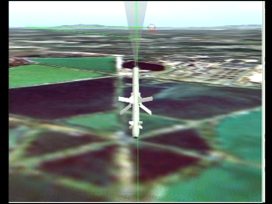With the spread of the Internet, the utopia was given a location in cyberspace. It was now a question of exploring, surveying, and settling this new continent. Those who departed for it dreamed the dream of a better world. In its immaterial expanses, new social models could be tested and new forms of life practised. Capitalism, racism, and all the other evils of the material world would be overcome. And what is more: it was not only the perfect counter-world, but also represented the next world order. Linked-up, decentralized, without hierarchies. This dream was of course also based on a new image of humankind.
Setting off for the New World
The cybernetic paradise was the place where all promises were to be fulfilled. The ideas about this legendary place were very modern. People seemed to realize that it would be not so much a concrete place as a non-place. Paradise functioned in the networks only as long as it, as such, had no name and no address. It was a state, a moment in which a network experienced an ideal balance between online and offline reality. Bruce Sterling was the first to promulgate this idea. In one of his cyber-thrillers1 in the late 1980s, the dissolution of political systems leads to an increase in decentralized life-experiments. Huge corporations in the hands of the producers, independent enclaves devoted to “data piracy”, and anarchistic liberated zones generate a varied information economy whose network also has room for enclaves: deregulated zones, so-called “islands in the Net”. A few years later, this maritime metaphor was adopted and developed by Hakim Bey. Sterling?s sci-fi scenario had partly become reality. The islands in the Net were given a new status. Their subversive potential was now what was emphasized. For the structures that began to form in cyberspace were all too similar to those that had arisen between the sixteenth and nineteenth century in the course of the discoveries and conquests of the naval powers: it was a capitalist system in whose lee Hakim Bey saw pirates and corsairs stretching an alternative “information network” around the globe. This network was made up of “scattered islands, remote hideouts where ships could be watered and provisioned, booty traded for luxuries and necessities. Some of these islands supported “intentional communities”, whole mini-societies living consciously outside the law and determined to keep it up, even if only for a short but merry life.”2 Data dandies in “Temporary Autonomous Zones” were to experience something similar.
The end of the information era
When Douglas Rushkoff proclaimed the end of the information era in 1997, a new chapter of it had just begun. Where Rushkoff saw imminent chaos, the infrastructure of the global players took on increasingly concrete forms. But the diagnosis of this New York cyber-critic could not be denied: “We are immersed in a popular culture that is already reckoning with the fact that humankind must accept its role as master of its own destiny.”3 God was dead. Human beings had taken His place. In this socio-cultural climate, the new media technologies, above all the Internet, seemed only to give more fuel to the fantasies of omnipotence associated with this fact. The fingertips of the “netizen” linked by the keyboard with the arenas of global “eyeball culture” contained the power of the Creator. On the banners in these arenas was written “self-empowerment” in all languages – the catchword of the WWW-democracy. God was responsible for building the Garden of Eden; now it was in the hands of the individual to create the cyber-paradise. A promise that was to be fulfilled at first mainly by corporations and states. Shopping islands were created on the Internet. At the same time, places of mass tourist pilgrimage were linked up. The Indonesian island of Bali, for example, was transformed into a “high-tech paradise”. “Here, young Indonesian programmers communicate in the international language of C++ and Java on behalf of corporate clients in Europe and North America.”4
The faith in the cybernetic paradise is still intact even after the collapse of the New Economy. In the regions where, between the sixteenth and the nineteenth century, people looked for new resources and possessions – generally known today as the Third World – the talk is of Special Economic Zones: as highly developed cyber-laboratories that cut themselves off from the miserable situation in the world directly outside; as highly controlled centres for global flows of information that have opened their gates wide to the global economy. In the Korean animation film “Sky Blue” (2004), this division into atopia and dystopia, already familiar from cyber-punk, is taken to an extreme with the reduction of the entire world to two cities: Ecoban, a technological paradise that has isolated itself from the polluted environment, and Marr, an uncultivated area inhabited by refugees. After the flood catastrophe of 26 December 2004, this metaphor can be also applied to the Indian Ocean. While most of the region, analogously to Marr, is reduced to rubble, one lonely island remains tranquilly in the water, untouched by the “Flood” (Die Zeit). Ecoban is really Mauritius, which has been talked about as the ultimate “cyber-paradise” since the start of the twenty-first century: “A tiny island in the Indian Ocean [that] is wiring itself to be an Internet hub – and has jobs for US techies.”5
Renaissance of the utopia
The appropriation of the utopia by commerce, and its subsequent ghettoization, have, since the last decade, certainly helped take the sheen off the idea of a better world held together by digital networks. Speechlessness and pessimism have spread through the camp of the “digerati”. Rudolf Maresch and Florian Rtzer have proposed a very surprising corrective to this trend. In their new book6, they put forward thirteen concepts whose common characteristic is that they all make the “new”, which promises things like information technologies, biotechnologies, and gene technologies, the focus of utopian thought in order to reconquer the material and immaterial resources of cyberspace.
However, the hype that descended upon the societies of the First World like a wave in the 1990s is not reproduced here. The dreams of the brave new world with a digital golden lining which, not without reason, have been discredited as neoliberal sugar-coating owing to the collapse of the New Economy – these dreams have released potent desires that can be seen as a breeding ground for utopias. In contrast with the anarchistic dreams of Hakim Bey, no more maps are to be distributed where the sought-after land of Utopia is indeed shown, but in a vague place that remains inaccessible. No, the unattainability of the utopian goal – which has always been characteristic of utopias – is to be called into question. The maps compiled by Maresch and Rtzer depict landscapes in which the utopias are within grasp and accessible: the linkage of all the computers in the world to form a “global brain” or the creation of social strata and real-time migration flows established on the Internet. The concepts take account of what is feasible, of the contradictory nature of society. In short: of reality. This characteristic, say the authors, will help utopias to experience a new renaissance.
Utopias were always the answer to the question: What do we lack? These media theorists from South Germany have published a collection of maps that turns the tables and asks: What does the utopia lack? The answer to this question is not a treatise on the deficiencies of utopias, but rather the consequence of the diagnosis, which is: utopias need a name, a place and, an address.
Bruce Sterling, Islands in the Net, New York 1988.
Hakim Bey, The Temporary Autonomous Zone, New York 1991.
Douglas Rushkoff, Children of Chaos, London 1997.
Warren Caragata, "Bali High-Tech Paradise", in: Asia Week, 27 April 2001.
Simon Robinson, "Cyber Paradise", in: Time, 28 October 2002.
Rudolf Maresch & Florian Rtzer, Renaissance der Utopie, Frankfurt am Main 2004.
Published 9 September 2005
Original in German
Translated by
Timothy Jones
First published by Springerin 1/2005 (German version)
Contributed by Springerin © Krystian Woznicki/Springerin Eurozine
PDF/PRINTNewsletter
Subscribe to know what’s worth thinking about.



